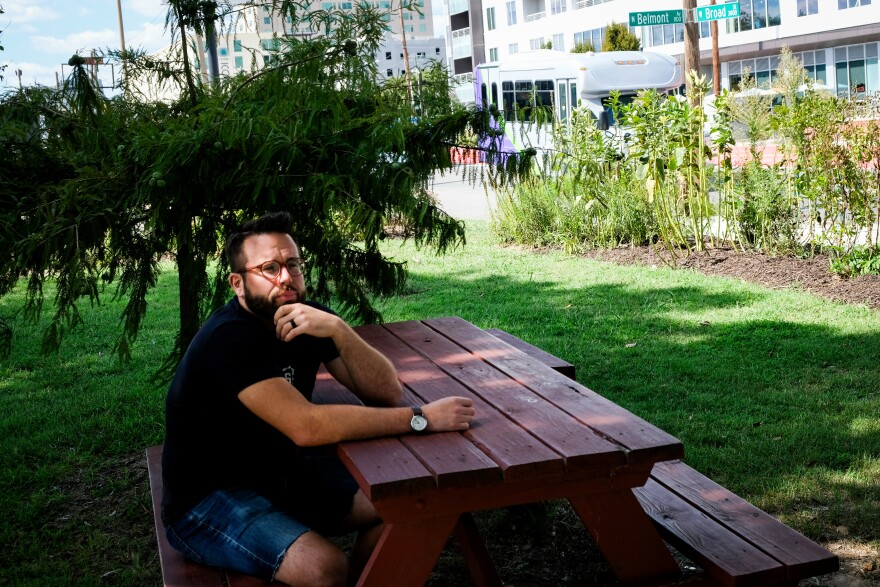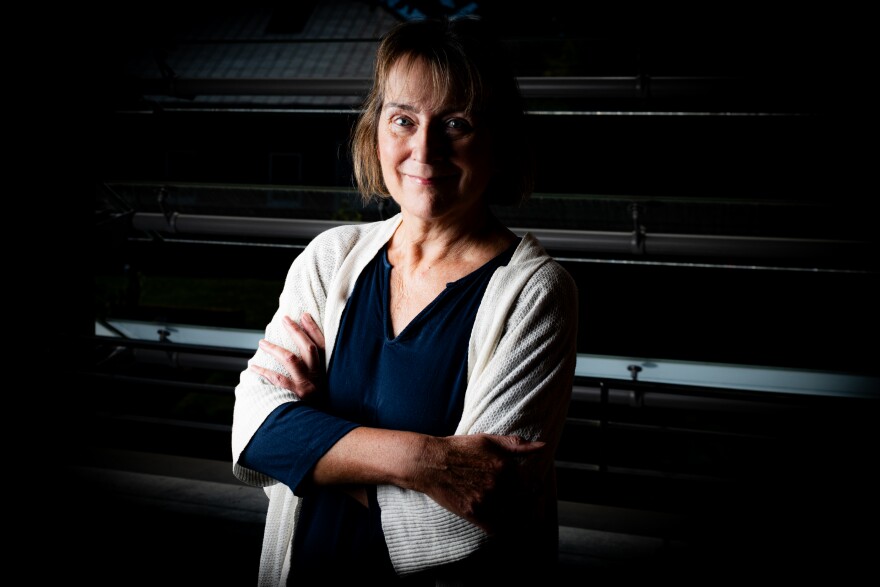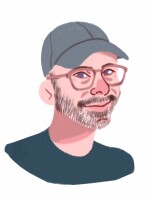How easy is it for people living in Richmond to find and get what they need? How equitable is it? How “healthy” is any Richmonder’s access to what’s needed to survive and thrive in 2023?
Donald Bennett is waiting near the corner of 15th and East Main streets for his daily ride on the Pulse, Richmond’s rapid transit bus, to Virginia Union University. His stop is steps away from the Main Street train station, while above his head are both Interstate 195 and multiple train tracks.
Unlike some of the other bus riders at this station, Bennett is not wearing noise-canceling headphones. He said his hearing is excellent, but sometimes the traffic sounds bother him — especially when trains go by.
“All I can say is trains are very loud,” Bennet said. “It’s got two tracks that run down each side. And when they come by, they screech really loud, and it hurts your ears for real.”
Nearby, Eric Teger is also waiting for the Pulse to take him to work at a construction site. He says the quietest time at this station is around 6 or 7 a.m. As soon as people start commuting around 9 o'clock, and the trains start rolling, the sound level kicks up. But he said it doesn’t bother him.
“I have noise-canceling earbuds, so I don’t hear anything. If I don’t have my earbuds, I’ll go home with ringing ears,” Teger said.
According to the Environmental Protection Agency, a direct line can be traced from noise pollution to people’s health. It defines noise pollution as “unwanted or disturbing sound” that interrupts daily activities — like sleep or conversations — and affects quality of life.
“And if you're not sleeping, that affects your immune system, and you become more susceptible to disease,” said environmental psychologist Jenny Roe. “It also affects our attention, our cognitive functioning, our ability to focus, and they affect our ability to function and feel well.”
According to Jeremy Hoffman, director of climate justice and impact at Groundwork USA and the former climate and earth scientist at the Science Museum of Virginia, that effect is felt most by people with low incomes and those facing housing instability.

At a tiny park near the intersection of Altamont Avenue and Broad Street in Richmond, Hoffman used an app to measure the noise level: the NIOSH Sound Level Meter. It was created in partnership by the National Institute for Occupational Safety and Health with the Centers for Disease Control and Prevention for anyone to measure the intensity of sound in any environment, said Hoffman.
The park is in Scott’s Addition, across the street from a new multi-family development and a Pulse station, as well as about a block away from single-family homes along a tree-lined street. In the middle of our conversation, a whiny, screeching motorcycle zoomed by.
"That just registered over 90 decibels,” said Hoffman. “That is something that you can only be exposed to for a matter of hours. If it were consistent. You could only be really exposed to that for so long before it becomes harmful to your ears.”
Hoffman said parks in very low-traffic neighborhoods have significantly lower sound intensities than the one on Broad Street, which had NIOSH levels at 94.9 dBs.
“The peak has been about 121 dBs,” said Hoffman, who added that people who are exposed to anything over 100 dBs only have about 15 minutes until it can damage hearing.
“Anyone that must be outdoors, whether it's people experiencing homelessness or people that rely on the public transportation system, they're going to be disproportionately exposed to this road noise than others in the same community,” said Hoffman.
Cutting through the noise

The amount and levels of noise people are subjected to depends on where you live, according to Hoffman.
“Studies have consistently shown that poor communities of color tend to have higher ambient noise levels, than wealthier, whiter communities within the same city,” Hoffman said. “We found that exact same pattern and extreme heat several years ago.”
Hoffman said one reason for this is because poorer neighborhoods tend to have less political weight to oppose development and minimize the amount of permitted traffic.
“Case in point, Jackson Ward was bisected by the interstate. So now, a historically Black neighborhood is positioned in close proximity to a high-traffic interstate system,” he said. “At the same time, wealthier, whiter communities in Richmond tend to have very little traffic going through them in no short way because of the ability for them to, to block and oppose development.”
But aren’t cities supposed to be loud? Hoffman said that’s not the case in other countries.
“It actually tends to be the case only in American cities,” Hoffman said. “Cities in Scandinavia and other parts of the world have very limited street traffic. Places that have shut down road access to cars, or limit the speed of the vehicles, see drops in the intensity of the noise. So, it's not that cities are loud, cars are loud.”

Jenny Roe, who is also the director of UVA’s Center for Design Health, says one thing cities can do to minimize noise pollution and improve health, is to create more natural environments by adding water features and more trees: “They have a restorative health function. They support our mental health in terms of helping us recover from fatigue and mood and stress.”
She co-wrote a book about it — Restorative Cities: Urban Design for Mental Health and Wellbeing. According to her, trees help screen out noise caused by cars in addition to trapping other types of pollution.
And she has more suggestions for city officials.
“They need to be thinking about the levels of noise, they need to be monitoring it, measuring it on a daily basis,” Roe said. “They need to be looking at the impact of noise on people on the streets, they need to be measuring people's health and wellbeing in relation to those exposures.”
Hoffman said another thing city officials can do to reduce noise pollution is to allow for more multifamily units to be built in quieter, greener, higher canopy neighborhoods, because not only do the trees absorb the sound, but traffic and construction noise tends to be less. He also added that lowering speed limits would reduce traffic noise.
“The sooner we start to see those connections between our health and the environment around us, [and] the built environment around us, the better we’ll be,” said Hoffman.
But there’s no getting away from the cacophony of sounds in a city entirely. And Roe cautions, while noise cancelling headphones might be helpful when you're standing beneath train tracks, they can also prevent you from being alert to your surroundings.




